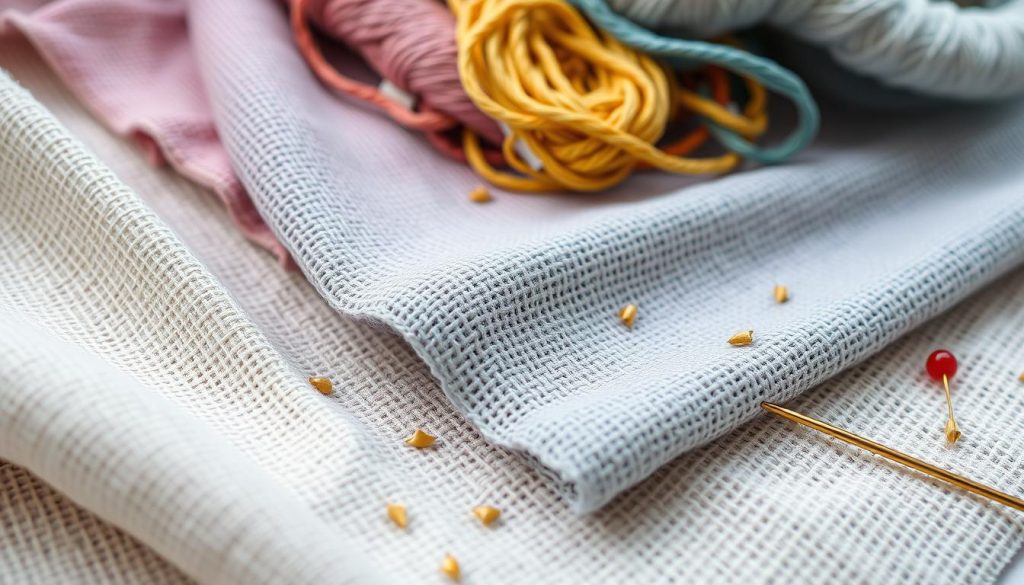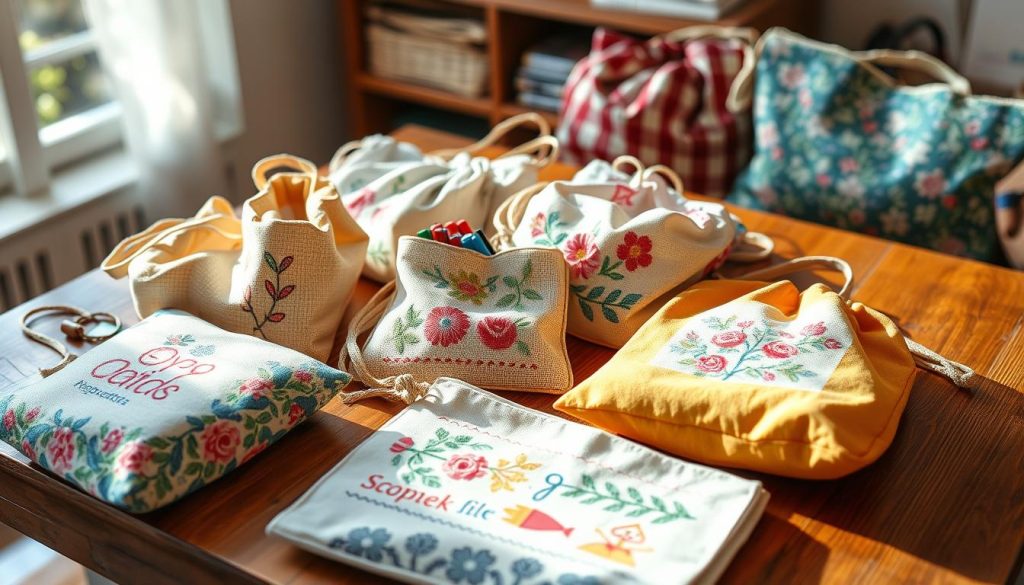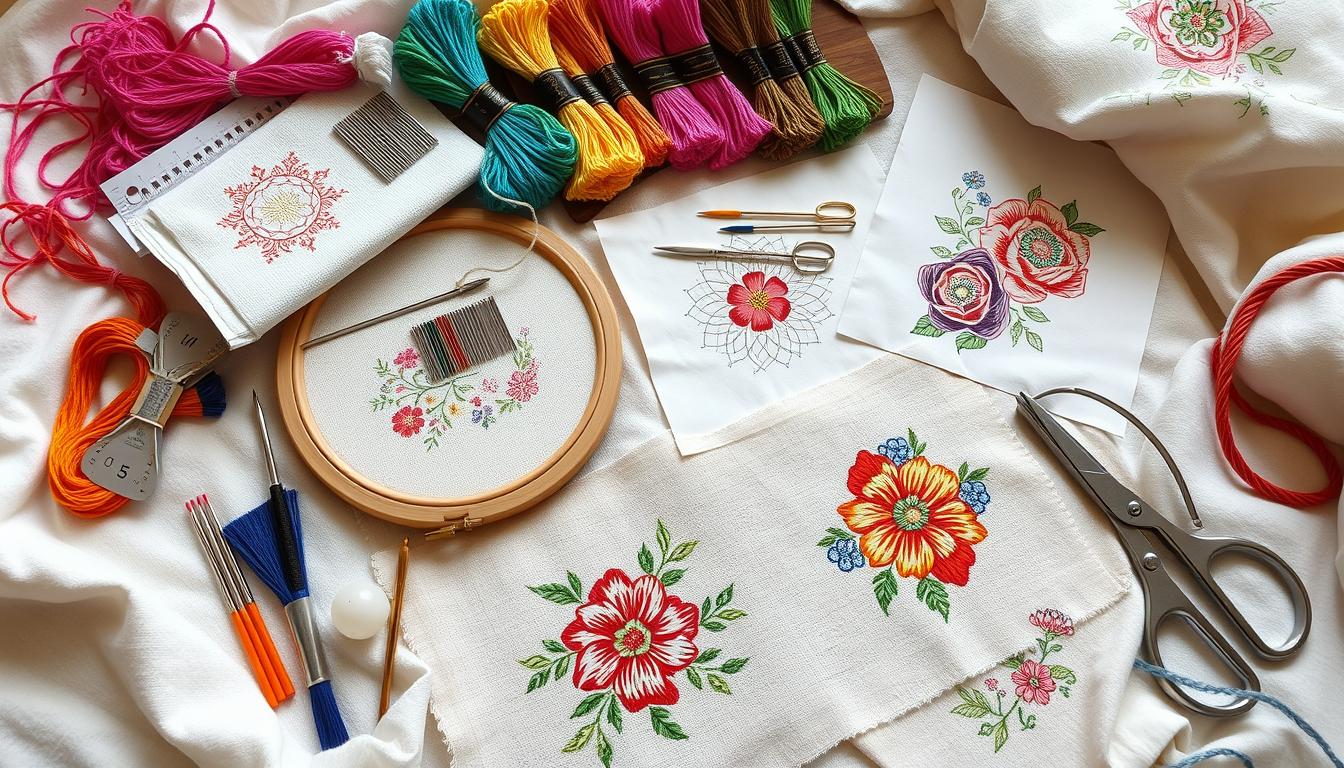Cross stitch is a hobby that’s both relaxing and rewarding. It doesn’t need a lot of tools to start. But, the right tools can make a big difference. A good kit can turn a boring task into a fun activity.
Whether you’re starting with a beginner cross stitch project or tackling more complex designs, you’ll need the right supplies. Here’s what you should have in your kit.
For beginners, you’ll need basic things like fabric, threads, needles, scissors, and a pattern. Brands like DMC and Zweigart offer top-notch materials. They have over 500 colors of stranded cotton threads and strong fabrics like Aida and linen.
For those who have been stitching for a while, there are more cross stitch accessories to make things easier and more fun. Tools like special needles and ergonomic hoops can make your crafting sessions better.
Key Takeaways
- Essential cross stitch supplies include fabric, thread, needles, scissors, and patterns.
- DMC and Zweigart are top brands for threads and fabrics.
- Additional accessories like embroidery hoops, q-snaps, and scroll frames can enhance the cross stitch experience.
- Pliers and tweezers, though underrated, are useful tools for cross stitch kits.
- Platforms like Etsy provide easy access to a wide range of cross stitch patterns.
Essential Cross Stitch Supplies
Starting a cross-stitch project needs the right tools and materials. Make sure you have these key items to begin smoothly.
Fabric
The base of any cross-stitch is the fabric. You’ll often use aida, Evenweave, or linen. Beginners usually start with aida, especially 14-count aida from brands like Zweigart.
The “count” shows how many stitches fit in one inch. For example, 14 count means 14 stitches per inch.
Threads
Choosing the right threads is crucial. Brands like DMC and Anchor offer six-stranded cotton floss in many colors. DMC threads are 100% Egyptian cotton.
They have a wide color range, making it easy to find the right shades. Metallic threads can also add special touches to your designs.
Needles
Using the right needles is key for smooth stitching. Size 24 tapestry needles are best for cross-stitching. They have long eyes for multiple threads and blunt tips that won’t harm the fabric.
The quality of your needles affects your comfort and precision while stitching.
Scissors
Sharp scissors are essential for cross-stitching. Get a pair of cross stitch scissors made for embroidery. Stork scissors are known for their precise cuts, important for trimming threads.
Also, consider a scissor case or sheath to keep the blades safe when not in use.
Patterns
Patterns guide your stitching. You can find simple designs for beginners or complex patterns for experts. Patterns can be bought or downloaded online, covering many interests and skill levels.
Brands like Bucilla and Dimensions offer high-quality patterns. They make your stitching experience more enjoyable.
Remember, good materials make a big difference in your cross-stitch projects. They improve both the quality and fun of your crafting.
Choosing the Right Cross Stitch Fabric
Choosing the right fabric for cross stitching is key for a great look and easy work. Knowing the different fabrics helps you pick the best one for your skill and project goals.
Aida Cloth
Aida cloth is the top pick for beginners. It’s made from 100% cotton and has a stiff, easy-to-count grid. It comes in counts like 14, 16, 18, and a special 6-count called Herta. Beginners often start with 14 count Aida for its balance of ease and beauty. Counts 16 and 18 offer a finer look but need more skill.
Evenweave and Linen
Evenweave, with counts like 25, 28, and 32, is stitched over two threads also they are softer and more flexible than Aida.. This makes it similar in size to 14 count Aida when using 28 count evenweave. Linen, made from flax fibers, has natural slubs and is loved by experts. It comes in counts from 28 to 50, perfect for detailed stitching.
Waste Canvas
Waste canvas lets you stitch on regular clothes and fabrics. It’s placed over the fabric, then removed after stitching. This adds a fun twist to your projects, making it easy to decorate clothes and accessories.

You might also want to try hand-dyed cross stitch fabric for extra flair. These fabrics come in many shades and patterns, adding depth and beauty to your work.
Types of Cross Stitch Needles
Choosing the right needle is key for smooth cross stitch. There are many types of needles, each with its own features. Knowing about them can make your crafting better.
Tapestry Needles
Tapestry needles are loved for their blunt tips. They stop threads from splitting. These needles are great for moving through fabric without damage.
They come in different sizes. This lets you pick the right one for your fabric and project.
| Needle Size | Suitable Fabric Count | Usage Notes |
|---|---|---|
| 20 | 6-count Aida | Ideal for coarser fabrics |
| 22 | 8-count Aida | Useful for medium-weight fabrics |
| 24 | 14-count Aida | Most beginner-friendly |
| 26 | 16-count Aida | Preferred by experienced stitchers |
| 28 | 18-count Aida | Requires delicate handling with one strand of cotton |
Gold-plated needles are cherished by many for their smooth glide through fabric and are particularly useful for intricate stitches like French knots.
Needle Sizes
Knowing about needle sizes is crucial for good stitching. The needle size should match the fabric count. This ensures smooth stitching and less thread breakage.
- Size 20: Best for 6-count Aida fabric.
- Size 22: Suitable for 8-count Aida fabric.
- Size 24: Works well with 14-count Aida fabric, ideal for beginners.
- Size 26: Perfect for finer stitches on 16-count Aida fabric.
- Size 28: Necessary for high-count fabrics, use with one strand of floss.
Choosing the right needle size is key for good stitching. Use a detailed guide to pick the best needle for your fabric. Twin pointed needles are good for frames, and milliner’s needles are great for French knots. Big eye or beading needles are perfect for seed beads.
The Importance of a Good Embroidery Hoop or Frame
Choosing the right support for your cross stitch project is key. Whether you pick cross stitch hoops, Q-Snaps frames, or scroll frames, keeping fabric tight and stitching easy is crucial. This section explores your options to find the best fit for your project.
Embroidery Hoops
Embroidery hoops are essential for cross stitch, keeping fabric tight. They come in sizes from 3 inches to 14 inches, made from wood, plastic, and rubber. You can find round, oval, rectangular, and polygonal shapes.
Screw and spring tension hoops offer different grip levels, perfect for various projects. Using a hoop with a stand can also reduce hand strain.
- Wood/Bamboo
- Plastic
- Flexible Rubber
Q-Snaps
Q-Snaps frames offer superior tension and adjustable fabric placement. Unlike traditional hoops, they clamp fabric firmly. They’re great for intricate designs and complex projects.
Q-Snaps improve chart visibility and ensure even tension. They also allow for two-handed stitching, speeding up your work.
Scroll Frames
Scroll frames are perfect for large projects. They roll the fabric securely, managing size and weight. They offer permanent setup, easy thread parking, and better posture.
Scroll frames maintain even stitch tension and are ideal for long sessions. However, they need more space and are less portable than hoops or Q-Snaps.
| Feature | Embroidery Hoops | Q-Snaps | Scroll Frames |
|---|---|---|---|
| Material Options | Wood, Plastic, Rubber | Plastic | Wood, Plastic |
| Size Variety | 3″-14″ | Various Sizes | Large Projects |
| Best Use | General Stitching | Complex Designs | Large Projects |
Additional Tools and Accessories to Enhance Your Cross Stitch Experience
Getting the right tools and accessories can make cross stitching better. A cross stitch lighted magnifier is a must-have. It makes small details clearer and eases eye strain.
Cross stitch needle threaders are great for those who find threads hard to manage. They save time, especially with many threads. The DMC Needle Threader, at AED 13.99, is a favorite among stitchers.
Cross stitch project organizers keep your work neat and within reach. Bobbin boxes help organize threads, making stitching easier. The DMC Plastic Bobbins (pack of 28) at AED 9.99 and the Handmayk Cardboard Bobbins (pack of 25) at AED 5.99 are good choices.
There’s more to enhance your toolkit. Cross stitch software lets you create unique patterns and turn photos into stitch designs. It blends technology with traditional stitching, leading to personal and unique projects.
An embroidery hoop stand can also be helpful. It supports your work without your hands, making long stitching sessions more comfortable. The Circulo Bamboo Embroidery Hoop at AED 21.99 and the DMC Wood Embroidery Hoop at AED 32.99 are durable options.
Investing in tools like cross stitch lighted magnifiers, cross stitch needle threaders, cross stitch project organizers, and cross stitch software can greatly improve your stitching. They let you enjoy the creativity and joy of cross stitching more.
Storage Solutions for Your Cross Stitch Materials
Finding the right storage for your cross stitch supplies is key. It keeps your materials organized and in good shape. Tools like project bags, floss organizers, and needle minders are crucial for this.
Project Bags
 Project bags are great for keeping your work tidy. They come in many sizes and styles. For example, rainbow drawers with seven parts are perfect for organizing fabrics.
Project bags are great for keeping your work tidy. They come in many sizes and styles. For example, rainbow drawers with seven parts are perfect for organizing fabrics.
Floss Organizers
It’s important to keep your threads untangled. Bobbin boxes help organize your floss. Usually, three boxes are enough to sort out a lot of colors.
Needle Minders
Needle minders are handy for storing needles when you take a break. They can be attached to your fabric or bag. This keeps your needles safe and easy to find.
Good storage solutions make your cross-stitching easier and safer. They also help keep your materials in great shape. Try out different storage options to make your crafting space better.
Conclusion
Starting cross stitch is easy and fun, with simple steps for beginners. You’ll need basic supplies like fabric, thread, and needles. You can also find special tools like embroidery hoops and floss organizers.
You can pick from affordable kits or high-end materials. This lets you choose what fits your style and budget. It’s all about making your crafting experience personal.
Cross stitching is more than just a hobby. It can help improve your brain and motor skills. It’s great for those recovering from injuries or strokes. Plus, it’s calming and can reduce stress and anxiety.
You’ll feel proud of your finished projects. The process itself is calming. Cross stitch is a rewarding craft that many people enjoy.
If you want to get better at cross stitching, there are many resources out there. You can find online tutorials, books, and stitching groups. They offer tips and advice to help you grow as a stitcher.
Cross stitching is loved for its beauty and peace. It’s a timeless craft that brings joy to many. Whether you’re new or experienced, there’s always something new to discover.
